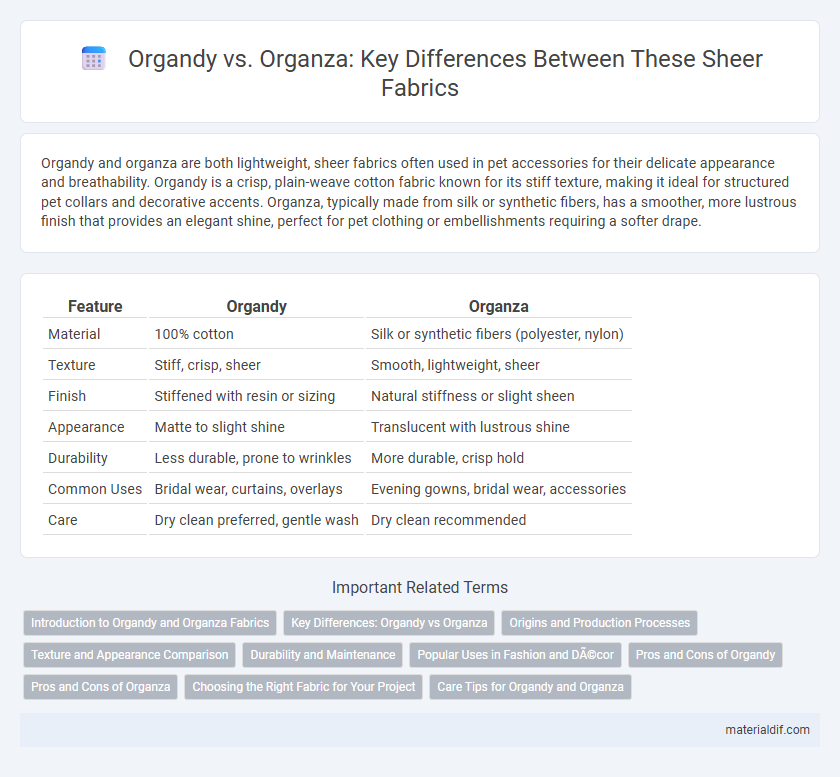Organdy and organza are both lightweight, sheer fabrics often used in pet accessories for their delicate appearance and breathability. Organdy is a crisp, plain-weave cotton fabric known for its stiff texture, making it ideal for structured pet collars and decorative accents. Organza, typically made from silk or synthetic fibers, has a smoother, more lustrous finish that provides an elegant shine, perfect for pet clothing or embellishments requiring a softer drape.
Table of Comparison
| Feature | Organdy | Organza |
|---|---|---|
| Material | 100% cotton | Silk or synthetic fibers (polyester, nylon) |
| Texture | Stiff, crisp, sheer | Smooth, lightweight, sheer |
| Finish | Stiffened with resin or sizing | Natural stiffness or slight sheen |
| Appearance | Matte to slight shine | Translucent with lustrous shine |
| Durability | Less durable, prone to wrinkles | More durable, crisp hold |
| Common Uses | Bridal wear, curtains, overlays | Evening gowns, bridal wear, accessories |
| Care | Dry clean preferred, gentle wash | Dry clean recommended |
Introduction to Organdy and Organza Fabrics
Organdy is a lightweight, sheer cotton fabric known for its crisp texture and delicate transparency, often used in summer garments and bridal wear. Organza, made from silk or synthetic fibers, features a stiffer and more lustrous finish, providing structure and elegance to evening dresses and couture designs. Both fabrics are prized for their translucency but differ significantly in fiber content and hand feel, making each suitable for distinct fashion applications.
Key Differences: Organdy vs Organza
Organdy is a crisp, sheer cotton fabric with a stiff finish achieved through a fine acid treatment, making it lightweight and breathable. Organza, made from silk or synthetic fibers, offers a smoother texture with a glossy finish and a slightly stiffer hand, providing a luxurious drape and sheen. Key differences include organdy's matte, crisp feel and natural fiber base versus organza's lustrous, smooth surface and blend of natural or synthetic fibers.
Origins and Production Processes
Organdy originates from Switzerland and is a finely woven cotton fabric treated with acid to achieve a transparent, crisp texture, making it ideal for lightweight garments. Organza, developed in Italy, is traditionally made from silk but now also from synthetic fibers, featuring a plain weave with a stiff finish achieved through heat-setting or resin treatment. Both fabrics undergo specialized finishing processes to enhance transparency and stiffness, but organdy relies on chemical treatment while organza utilizes heat or resin stabilization.
Texture and Appearance Comparison
Organdy fabric features a crisp, sheer texture with a matte finish that provides a structured yet lightweight feel, making it ideal for voluminous garments and delicate overlays. Organza boasts a smooth, glossy surface with a stiffer hand, lending a shimmering, translucent appearance that enhances the elegance of eveningwear and bridal designs. Both fabrics offer transparency but differ in tactile firmness and luster, with organdy presenting a more matte and delicate texture compared to organza's shiny and rigid profile.
Durability and Maintenance
Organdy is a crisp, lightweight cotton fabric that tends to be less durable and more prone to wrinkling and damage from repeated washing, requiring gentle hand washing and careful ironing. Organza, made from silk or synthetic fibers like polyester, offers greater durability with its stronger weave and better resistance to wear and tear, maintaining its stiffness and sheen with less delicate maintenance. While organdy demands more meticulous care to preserve its transparency and texture, organza withstands frequent cleaning and retains shape longer, making it more suitable for garments and decor needing durable, easy-care fabric.
Popular Uses in Fashion and Décor
Organdy is highly favored for bridal gowns and summer wear due to its lightweight, crisp texture and sheer appearance, providing an airy elegance that enhances delicate silhouettes. Organza, thicker and smoother with a subtle sheen, is widely used in evening dresses, overlays, and decorative curtains, offering structured volume and a luxurious finish. Both fabrics play key roles in fashion and decor, with organdy emphasizing softness and lightness, while organza adds formality and sophistication.
Pros and Cons of Organdy
Organdy fabric is a lightweight, sheer cotton textile known for its crisp texture and excellent breathability, making it ideal for summer garments and delicate overlays. Its main advantages include superior durability compared to organza and a matte finish that resists wrinkling, but it tends to be less smooth and slightly less glossy. However, organdy can be stiff and less fluid in drape, which limits its use in designs requiring soft movement or flow.
Pros and Cons of Organza
Organza is a lightweight, sheer fabric known for its crisp texture and elegant sheen, making it ideal for formal wear and bridal gowns. Its pros include excellent structure retention and a luxurious appearance, while its cons involve its delicate nature and tendency to wrinkle easily. Organza is less breathable compared to organdy and requires careful handling to prevent tearing or fraying.
Choosing the Right Fabric for Your Project
Organdy is a crisp, sheer cotton fabric ideal for structured garments and lightweight curtains, offering breathability and a matte finish. Organza, a silk or synthetic silk-like fabric, provides a stiffer texture with a smooth, glossy surface, perfect for evening wear and decorative overlays. Selecting between organdy and organza depends on desired stiffness, sheen, and fabric weight to best suit garment drape and project requirements.
Care Tips for Organdy and Organza
Organdy and organza require delicate care due to their lightweight, sheer qualities, often made from cotton and silk blends respectively. Hand washing in cold water with mild detergent preserves the fabric's crispness and sheen while avoiding harsh wringing prevents distortion of the fine weave. Ironing with a low heat setting and using a pressing cloth helps maintain the delicate texture and prevents scorching or melting on both organdy and organza fabrics.
Organdy vs Organza Infographic

 materialdif.com
materialdif.com